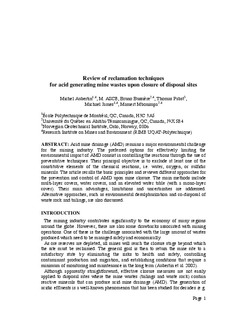| dc.contributor.author | Aubertin, Michel | |
| dc.contributor.author | Bussiere, Bruno | |
| dc.contributor.author | Pabst, Thomas | |
| dc.contributor.author | James, Michael | |
| dc.contributor.author | Mbonimpa, Mamert | |
| dc.date.accessioned | 2017-04-12T07:01:08Z | |
| dc.date.available | 2017-04-12T07:01:08Z | |
| dc.date.created | 2017-02-21T11:39:34Z | |
| dc.date.issued | 2016 | |
| dc.identifier.citation | Geotechnical Special Publication. 2016, 2016-January (270), 343-358. | |
| dc.identifier.issn | 0895-0563 | |
| dc.identifier.uri | http://hdl.handle.net/11250/2437493 | |
| dc.description.abstract | Acid mine drainage (AMD) remains a major environmental challenge for the mining industry. The preferred options for effectively limiting the environmental impact of AMD consist in controlling the reactions through the use of preventative techniques. Their principal objective is to exclude at least one of the constitutive elements of the chemical reactions, i.e. water, oxygen, or sulfidic minerals. The article recalls the basic principles and reviews different approaches for the prevention and control of AMD upon mine closure. The main methods include multi-layer covers, water covers, and an elevated water table (with a mono-layer cover). Their main advantages, limitations and uncertainties are addressed. Alternative approaches, such as environmental desulphurization and co-disposal of waste rock and tailings, are also discussed. | |
| dc.language.iso | eng | |
| dc.title | Review of the Reclamation Techniques for Acid-Generating Mine Wastes upon Closure of Disposal Sites | |
| dc.type | Peer reviewed | |
| dc.type | Journal article | |
| dc.source.pagenumber | 343-358 | |
| dc.source.volume | 2016-January | |
| dc.source.journal | Geotechnical Special Publication | |
| dc.source.issue | 270 | |
| dc.identifier.doi | 10.1061/9780784480137.034 | |
| dc.identifier.cristin | 1452719 | |
| cristin.unitcode | 7452,18,0,0 | |
| cristin.unitname | Ingeniørgeologi og bergteknikk | |
| cristin.ispublished | true | |
| cristin.fulltext | postprint | |
| cristin.qualitycode | 1 | |
